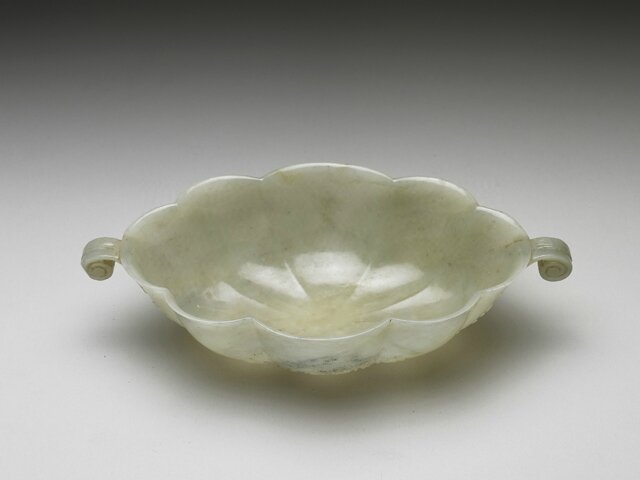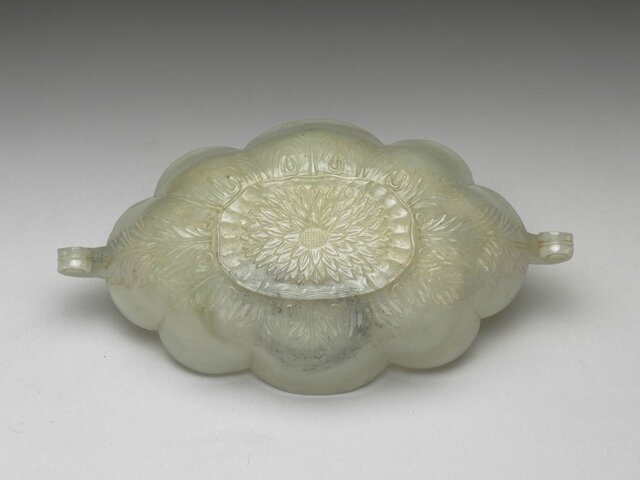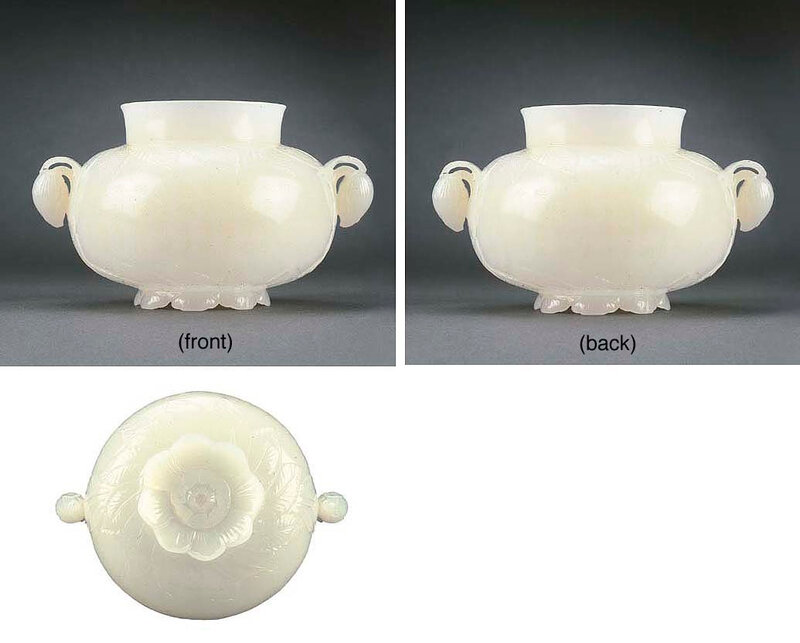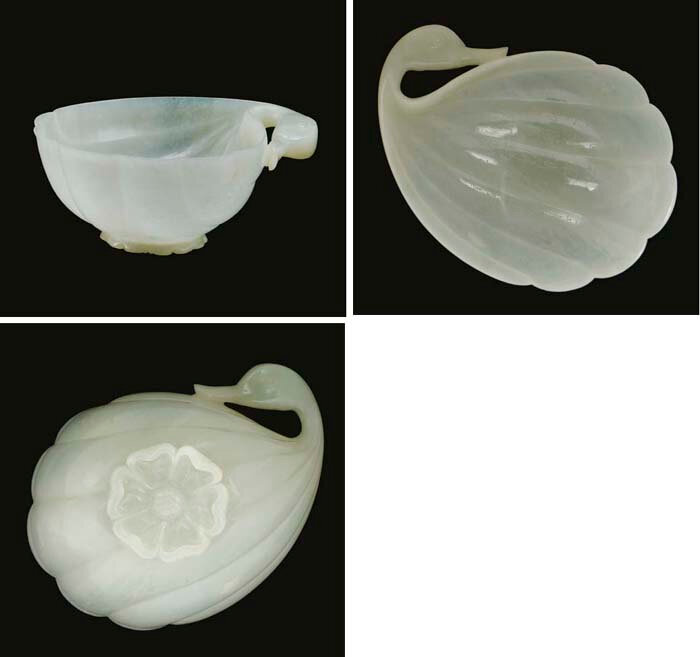A highly important Mughal white jade shell-formed cup, 17th century, inscribed with a Qianlong imperial poem dated to 1774
Lot 1593. A highly important Mughal white jade shell-formed cup, 17th century, inscribed with a Qianlong imperial poem dated to 1774; 7¾ in. (19.5 cm.) wide. Estimate on request. Price realised HKD 19,000,000. © Christie's Images Ltd 2008.
Magnificently carved in the form of a delicate shell, the thin lobed walls carved to the exterior in high relief with a large central gardenia flower, its delicately folding petals forming the shallow foot set before eight radiating serrated acanthus leaves emerging from a curled lip and bordered by a further band of smaller acanthus leaves, two of the larger leaves terminating at the edges of the outermost lobes and folding over to form leaf-shaped scroll handles, the interior walls with conforming flutes lightly incised with a lengthy Imperial inscription in praise of the Mughal vessel, the well-polished translucent material of an exceptionally even creamy white tone, box.
Provenance: An important private collection formed in the late 19th/early 20th century
The Canton Collection.
Literature: Min Chiu Society Silver Jubilee Exhibition : Anthology of Chinese Art, Hong Kong, 1985, pl. 217.
Exhibited: Min Chiu Society Silver Jubilee Exhibition : Anthology of Chinese Art,Hong Kong, 25 October 1985 - 15 January 1986.
Note: The inscription may be translated as:
Jades from Western Kun are matchless for their skilled craftsmanship;
water mills grinding the jade to thinness of paper.
Making this drinking vessel in the form of a large bowl;
the shape is recorded by craftsmen in the Zhouli.
Half a bulging caltrop, furled lotus leaf,
a gardenia supporting the base.
One could compare it to an opened oyster shell,
like a bright moon clearly reflected in water.
The hand finds no blemishes but the eye can find hints
of how it was conceived and executed.
The tools handled with clever contrivance and clear determination,
I am simply unable to suppress the desire to gaze upon it repeatedly.
Imperial inscription by (Emperor) Qianlong, the first ten days of the second (lunar) month in Spring of the Jiawu year.
The inscription is followed by a two-character seal, Langrun, meaning 'Bright and translucent'.
The Chinese Emperor Qianlong (r.1736-95) was renowned for his patronage and appreciation of the arts. One of his great passions was jade, and among those items he particularly treasured were some he termed 'Hindustan' (Hendusitan or Wendusitan) jades. Such was his fascination with these foreign jades that in 1768 he wrote a scholarly text on the geography of Hindustan and the derivation of its name, identifying an area in what is now northern India centering on the city of Agra. In the eighteenth century this area was part of the Mughal Empire and thus the jades are today often referred to as 'Mughal' jades. Jade carving had reached new heights under the rule of the great Mughal Emperor Shah Jahan (1627-58), and it was this style that appears to have particularly appealed to the Qianlong Emperor, although he also collected jades from other parts of the Muslim world.
It has been noted that when Emperor Qianlong married Xiang Fei, the daughter of a Uighur chieftain, in 1760, the union served to establish links between China and the West, and enabled a flow of beautiful jades to be sent to Court from the Xinjiang region. When the Qianlong Emperor's admiration for Mughal jades was known, foreign princes sent them as gifts, while Qing dynasty officials presented them as tribute. The Emperor displayed these jades in some of the most important palaces within the Forbidden City, such as the Palace of Heavenly Purity, the Hall of Mental Cultivation, and the Palace of Longevity. However, he was not only a passionate collector, he also enjoyed studying works of art and composed prose and poetry about them. Seventy-four works of Qianlong's recorded prose and poetry commemorate jades from western lands, and, on the emperor's instructions, a number were inscribed onto the pieces themselves.
This beautiful cup exemplifies the qualities that the Qianlong Emperor admired in Mughal jades. The stone itself is extremely fine, the design is elegant, and the skill of the lapidary who created it is exceptional. Interestingly, in the poem Qianlong commanded to be inscribed on the cup, dated 1774, the emperor mentions Xi Kun, which refers to Khotan, now in Xinjiang Province. Khotan is famous for its fine nephrite jade and the beautiful, almost luminous, white jade of this cup may well have come from there. The emperor may also have mentioned this region, since it was through Xinjiang that many of the Mughal jades entered China.
The melding of complementary natural forms is a characteristic of these jades that appealed to Qianlong. His inscription makes clear that he cannot decide if the shape of the cup resembles an up-turned lotus leaf or a shell, but in any case he likens its overall appearance to the moon reflected on the water. The choice of a gardenia blossom to provide the base on which the cup rests is also appropriate to the colour and texture of the jade. The emperor remarks upon the skilful carving, which although in very low relief, gives a clear impression of three-dimensionality. Qianlong could feel no surface changes with his fingers, but his eyes could see the layers of decoration. The Western lapidaries were also famous for the fact that their carving was so well finished that no trace of the lathe remained, and the emperor repeats the myth that they carved jade using water.
Seeing this exquisite cup one can well understand the final line of the emperor's poem: 'I am simply unable to suppress the desire to gaze upon it repeatedly'.
The carving of the present vessel is dated to the 17th century and the closest comparable example is the famous Shah Jahan cup (fig. 1) from the Victoria and Albert Museum collection, London, illustrated by G. Wills, Jade of the East, London, 1972, p. 157, no. 137. The Shah Jahan cup is also carved of scallop form, raised on a floral bloom base and is inscribed with the year 1067 of the Muslim era, corresponding to 1657. Another comparable 17th century example of this scallop-form Mughal jade, carved with a lotus flower on the base, flanked by a pair of acanthus leaves as handles and without an inscription on the interior, was included in the exhibition, Exquisite Beauty - Islamic Jades, National Palace Museum, Taipei, 2008, and illustrated in the Catalogue, p. 88, no. 87.
Wine cup made for the Emperor Shah Jahan, 1657, India, white nephrite jade. Museum no. IS.12-1962, © Victoria and Albert Museum, London.


Flower Shaped Bowl and Two Leaf Shaped Handles, Mughal Empire. Length: 15.8 cm, width: 8.7 cm, height: 3.6 cm © National Palace Museum of Taipei, Taiwan.
Examples of Qianlong inscribed Mughal jades in private collections are extremely rare. An example is a Mughal white jade compressed oval-shaped jar, carved with a pair of down-turned floral bud handles and supported on a floral bloom foot, inscribed with a Qianlong poem dated to the Guimao cyclical year, corresponding to 1783, sold at Christie's London, 12 November 2002, lot 54.(see fig.2) Compare also a number of white jade vessels carved in Mughal style from the Qianlong period, such as the white jade fluted cup carved with a goose-head form handle and resting on a mallow flower base, also bearing a Guimao cyclical date, sold at Christie's London, 11 November 2003, lot 68.
An exquisite imperial inscribed Mughal white jade jar, guan, Qianlong Guimao cyclical date corresponding to 1783 and of the period; 5½ in. (14 cm.) wide. Sold for GBP 391,650 at Christie's London, 12 November 2002, lot 54. © Christie's Images Ltd 2002.
Cf. my post: An exquisite imperial inscribed Mughal white jade jar, guan, Qianlong Guimao cyclical date, 1783 and of the period
A fine and rare imperial Mughal-style white jade cup, shuiyu, Qianlong inscription, circa 1783; 5 9/16 in. (14 cm.) wide. Sold for GBP 229,250 at Christie's London, 11 November 2003, lot 68. © Christie's Images Ltd 2002.
Cf. my post: A fine and rare imperial Mughal-style white jade cup, shuiyu, Qianlong inscription, circa 1783
Christie's. The Imperial Sale including Elegance and Artistry. Treasures from a Private Collection, Hong Kong, 27 May 2008

/https%3A%2F%2Fprofilepics.canalblog.com%2Fprofilepics%2F1%2F0%2F100183.jpg)
/https%3A%2F%2Fstorage.canalblog.com%2F03%2F02%2F119589%2F96711876_o.jpg)
/https%3A%2F%2Fstorage.canalblog.com%2F11%2F31%2F119589%2F94773502_o.jpg)
/https%3A%2F%2Fstorage.canalblog.com%2F20%2F83%2F119589%2F94772815_o.jpg)
/https%3A%2F%2Fstorage.canalblog.com%2F26%2F72%2F119589%2F75604929_o.jpg)
/https%3A%2F%2Fstorage.canalblog.com%2F59%2F60%2F119589%2F26458628_o.jpg)







/image%2F1371349%2F20240406%2Fob_a54acc_435229368-1644755382961141-18285727260.jpg)
/image%2F1371349%2F20240229%2Fob_b1ea4c_429582962-1625285201574826-43586635599.jpg)
/image%2F1371349%2F20240229%2Fob_84bc3b_429558450-1624783464958333-37673404077.jpg)
/http%3A%2F%2Fstorage.canalblog.com%2F36%2F88%2F119589%2F129555285_o.jpg)